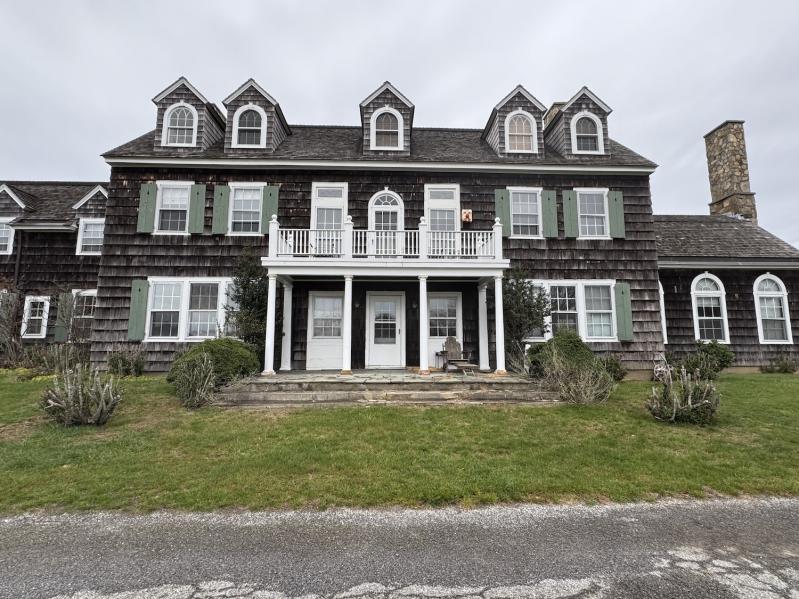“I was 10 or 11 when my father bought that house in 1956 from Carl Fisher’s widow,” Bill Akin said last week about the Carl Fisher House on Foxboro Road in Montauk.
Fisher purchased the entire Montauk peninsula, nearly 10,000 acres, in 1925, with plans to make it into the Miami Beach of the North. He lost his fortune before World War II, but his house was left standing and was even used by the military for a stretch.
Now a locally designated historic landmark owned by East Hampton Town, the Fisher House will celebrate its centennial next year with a massive facelift, courtesy of about $3.7 million in community preservation funds. Plans for its restoration were announced at the Oct. 14 town board meeting and unanimously supported by the board.
The Akin family sold the house and its 7.5 acres to the town for $5.56 million in 2021, after years of discussion.
Back in 2017, “We made a presentation in the C.P.F. committee and were received very well,” said Joe Gaviola, the president of the Montauk Historical Society, which has licensed the property since February 2022. In 2017, though, the town opted not to purchase the property because there wasn’t enough money in the C.P.F.
“Lo and behold, Covid happened, and all those transfer tax funds came into the C.P.F. and we got a second bite at the apple,” Mr. Gaviola said.
Since 2022, the historical society has used the house at 44 Foxboro Road for fund-raisers, lectures, and exhibitions, most recently about the prohibition years in Montauk. When the restoration is complete, the society’s offices will be located in the building.
Mr. Akin’s family lived in the house during the summers until he was old enough to join the Navy. When he returned to Montauk, he lived in what was originally the caretaker’s house for many years, before building his current house a few hundred yards away.
“We bought the house because my father’s business” — he sold conductors used by Grumman — “had a lot of customers in the middle of Long Island. They loved to come out and go fishing. Every weekend through the fall he’d take different customers out bass fishing,” said Mr. Akin.
He also remembered hearing bobwhites (now locally extirpated except for a few recently introduced birds), unsuccessfully hunting rabbits with a bow and arrow, and more successfully shooting skeet with his father from a concrete platform just off the driveway. “It’s still there,” Mr. Akin said, explaining that his father would often host skeet contests with boat crews.
Scott Wilson, the town’s director of land acquisition and management, gave a broad outline of the work to be done, with the goal of breaking ground in early 2026. Construction should take about a year, he told the board.
New windows, doors, Americans With Disabilities access both at the entrance and bathrooms, and a fire escape (it’s a three-story structure) are all planned. There are three chimneys that need repairs, as well as the roof. Access will also be improved, with a widening of the driveway and an enlarged parking area.
The house will also be reinsulated, and the heating and air-conditioning system will be completely revamped. Everything will be electric. A new I/A septic system will be installed.
“We’re going to do our best to make it look exactly like it was when it was first built,” said Mr. Wilson, explaining that interior details would be preserved. The building is now shingled but was originally white. “We’re going for historic restoration here, So, they will be white again.”
Councilman Ian Calder-Piedmonte explained that the town can use up to 10 percent of annual C.P.F. revenues on historic properties — to purchase them outright or for restorations, for example — but it doesn’t roll over. He praised the “strategic planning” of Mr. Wilson and the town’s property management committee (to which he is the board’s liaison) to use the money before it disappears.
“We have a lot of these historical structures that we want to keep maintained,” he said.
“We’re living in an age where it’s all too easy to see buildings and structures like this torn down and destroyed,” said Councilman Tom Flight. “This is such an incredible part of our town’s history.”
“A big part of the story of the house has nothing to do with the house at all, but the property,” Mr. Akin said. “It was originally 27 acres. My brother and I bought six additional lots to keep the sanctity of the expanse of the property without houses staring in on it. Before that, the Suffolk County Water Authority put in two wells. Those wells are still some of the most important in Montauk.”
“It’s like a dream come true for you to commit another $3.7 million to us,” Mr. Gaviola told the board. “It’s kind of amazing for Montauk that we have this place forever, Bill,” he said, turning to Mr. Akin, “It’s like, as cool as it gets for us.”
Councilman David Lys said the town board would finalize documents and soon bring a resolution to put the project out to bid.




